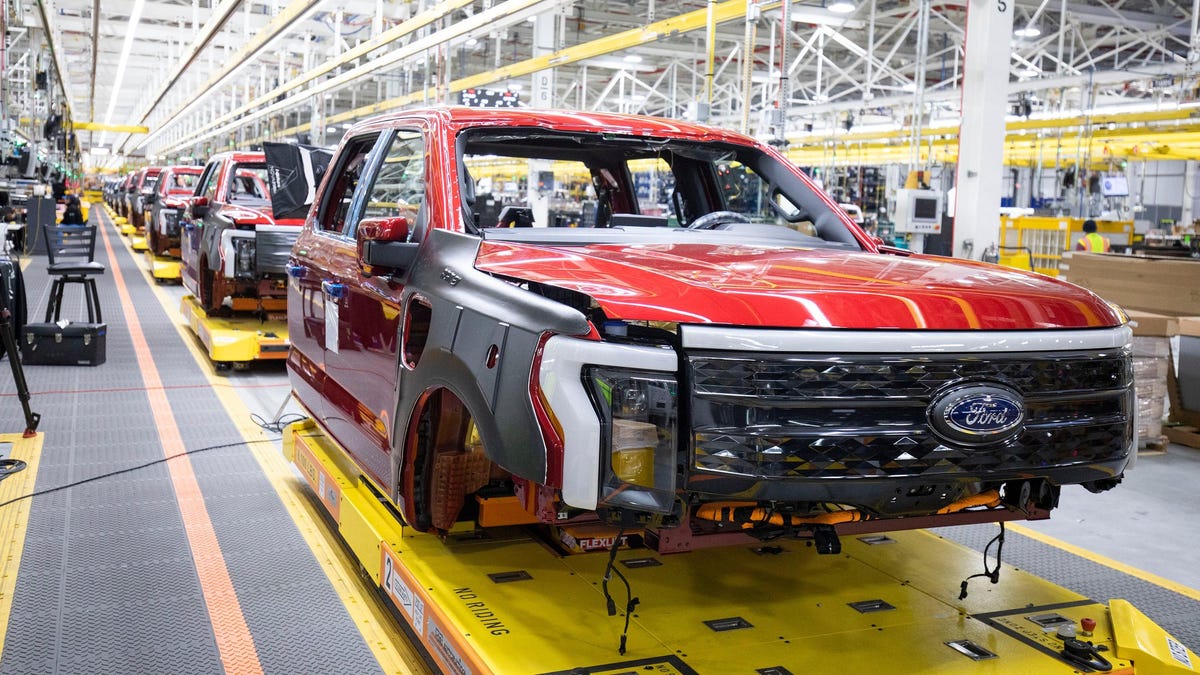No, EVs Are Not Going to Take Away America's Auto Factory Jobs

Ford F-150 Lightning pickup trucks roll through the assembly line at the Ford Rouge Electric Vehicle Center in Dearborn, Michigan.Photo: Bill Pugliano (Getty Images)
Auto manufacturing in the U.S. has been in decline for decades mostly due to offshoring and automation. Now, the EV transition threatens to speed up the decline of U.S. auto production by reducing the amount of workers needed at assembly lines, according to CNBC. This could end up cutting jobs across the American Midwest, in Indiana, Michigan and Ohio.
Is the third-generation Mustang a winner or a dud?
01:18
Friend or Fiero? Pontiac’s Mid-Engine Sports Car
37 minutes ago
Electric cars have fewer components than ICE-powered cars; fewer moving parts means fewer working people, right? Well, not necessarily. While researchers say EVs will require 30 percent less manufacturing labor to produce than conventional cars, EVs will not necessarily require fewer workers.
So, before we start blaming EVs for cutting job in the U.S., it’s important to understand that the decline of domestic manufacturing — in the auto industry and beyond — began with the introduction of automation. I encourage you watch the following CNBC report, which details the history of auto production in the U.S., and predicts where it could be going in the age of EVs:
Will EVs Ruin The Midwest Economy?
It’s objectively true that EVs are simpler machines than combustion-powered cars. EVs need less maintenance, less service and require less labor to make. The thing is, though, that labor and manufacturing capacity in the U.S. has been trending downward for years because production has become more efficient. In 2022, 235-240 auto workers can do what would’ve taken 1,000 workers to do in 1970.
In the half-century since then, manufacturing has become almost too efficient for its own good, and this came with the advent of automation. At its height, U.S. manufacturing had a workforce of 19.55 million. By 2019, the number was 12.83 million. And out of those, just over 1 million work in the auto sector now.
That’s all to say that EVs haven’t cut auto worker jobs yet, or won’t have to cut auto making jobs as dramatically as some would lead us to believe — it was robots. But it’s not all bad news. Now seems like a good time to retrain U.S. workers who’ll keep making cars, or train those who’ll make EVs in the future. It’s not about less workers, but different workers — across different sectors.
G/O Media may get a commission

Eco-friendly, comfort-friendly
Their multi-occasion styles take you from the office, to dinner, to neighborhood errands, with a sugarcane-based foam bottom and slick recycled leather upper.
Battery metals need mining and processing. Semiconductors and their circuit boards need pressing. All of the industries on which EVs will depend on are primed for a return to domestic factories. Major auto suppliers in the Midwest will just have to adapt as things like fuel lines are no longer necessary.
Suppliers like NGK or Bosch will see the market shrink to a fraction of what they are now. As much as me and my old BMW are grateful for NGK Iridium spark plugs, the company will have to branch out to stay afloat and keep its workers. The electric transition is hardly over: global EV adoption is only at nine percent. But the OEM landscape will be different by 2035. Hopefully, by then, what jobs we lose in the EV transition will be replaced and then some.
Photo: Mandel Ngan (Getty Images)



